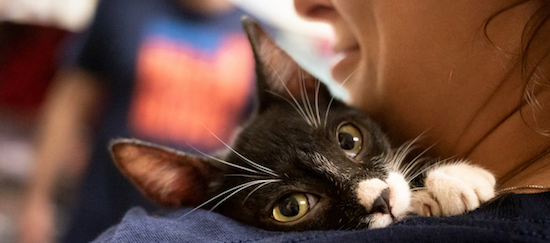In an average animal shelter, you are likely to hear from staff and leadership that they are saving most, if not all of the, ‘healthy and treatable’ animals in their care. Sadly, in the majority of shelters, animals that are classified as ‘unhealthy and untreatable’ are pets who are simply not given a chance at a live outcome. These nine groups of savable pets are less likely to receive care – and eventual placement – and more likely to have their lives needlessly ended.
- Geriatric animals. Really old pets come into shelters for all kinds of reasons. Sometimes their owners cannot afford their medical care. Other times they’re brought in when their owner becomes sick or passes away; and in many other cases they simply show up as strays and are never reclaimed. Old animals, even healthy ones, are more likely to be euthanized because of the misconception that ‘no one wants a geriatric pet.’ These days, No Kill shelters have shown this simply isn’t true – older animals are often the first ones picked by adopters and foster caregivers. Despite this evidence, many shelters still routinely kill animals just because they’re old.
- Tiny puppies and kittens. Shelters without foster programs or rescue partners say they don’t have the resources to save very young animals. That means neonatal kittens and puppies in the first weeks of life are often immediately euthanized, even though starting a foster program to help orphaned pets is inexpensive and fairly simple. You can learn how to save the lives of these tiny, vulnerable kittens at our Maddie’s Lifesaving Academy Neonatal Kitten Apprenticeship.

- Less social cats. In communities where there are no working cat or trap-neuter-return programs, cats that don’t want to be picked up, held, and petted by strangers are often given no chance at a live outcome and instead are euthanized due to being ‘fearful, feral or unhandleable.’ Shelters who have taken steps to create a strong community cat program like Kansas City Pet Project, in Kansas City, MO, prove that it is possible to save every single non-social cat in their care, making this kind of killing inexcusable. Even in some places where these programs do exist, cats are still at risk of euthanasia if they’re not cuddly and friendly with people in the shelter. In lifesaving shelters, programs treat cats as individuals and implement enrichment programs like the Jackson Galaxy Cat Pawsitive clicker training program to help unsocialized cats become more adoptable.
- Animals with treatable, contagious illnesses. Some hard truth: A common cold or upper respiratory infection (URI) is often a death sentence for shelter pets. The idea behind this is that because those pets are potentially contagious to other pets, and therefore should be removed or ‘culled’ from the population so they do not spread disease. These pets are often euthanized even though their symptoms are very minor and often resolve with minimal or no treatment. Beyond a routine URI, some of the other treatable shelter sicknesses that lead to needless euthanasia include parvovirus, distemper, Calicivirus, and even skin ailments like mange and ringworm. Building robust foster programs, creating isolation spaces, vaccinating on intake, and implementing proven treatment protocols are all ways to save more contagious, sick animals.
- Injured Pets. Free-roaming cats and dogs may be brought into animal shelters by good Samaritans or animal control officers when they have been injured and need immediate medical support. Often, especially in shelters without veterinarians on staff, these pets are euthanized if they have a broken bone or other wounds that require veterinary care. These pets could be easily saved with medical care, and for shelters without a veterinarian, they can be sent to an off-site veterinarian.
- Fearful and stressed out dogs. Even the best animal shelter is still a terrifying place for the average dog. Despite this, dogs are routinely killed for being shy, fearful, and/or stressed out in their kennels. The justification given is that these dogs are not desirable adoption candidates or that they cannot be immediately handled by the average person. In lifesaving shelters, they’ve learned that the public wants to help save the lives of scared or stressed out dogs and puppies. In fact, many people actually gravitate towards these pets because they want to be part of helping a shut-down dog come out of its shell and find happiness and security with a new family.
- Pets that have been victims of cruelty, abuse, or neglect. When we think of animal shelters, most people believe they are true safety nets for animals that have been rescued from abusive situations. Unfortunately, in many shelters, pets who are confiscated from these cases are not given the time they need to recover medically or behaviorally. If the pet has special needs as a result of the pain they suffered, they’re sometimes written off as ‘unadoptable’ and not given a chance at rehabilitation and a new home.
- Any pet with a ‘bite’ history. In most states, a legally reportable ‘bite’ is any time a tooth of an animal breaks on a human. If you’ve ever owned a puppy, you have likely experienced firsthand how sharp their teeth can be and how easily their teeth can break skin. Bites are reported for the purpose of potential rabies exposure and have no reflection on the intention or temperament of the dog whose tooth broke skin. Bites can be accidental or minor, or they can be life threatening, aggressive attacks. Even though there is a wide variance in type and circumstances of bites, some shelters still indiscriminately kill any dog whose tooth has broken skin without any regard for the circumstances surrounding the incident.

- Cats and dogs with chronic but easily manageable conditions. Pets are just like people in the way some develop chronic medical conditions. These may be caught from other animals (as in the case of FeLV and FIV) or may be related to age or genetics, like diabetes or renal disease. Most of these can be managed with medication and supportive care. These pets often win over the hearts of fosters and adopters and are not hard to place in homes. Because they require ongoing care, shelters assume no one will want them and euthanize them without ever telling the public they need help. It’s easy to make an immediate change by telling the public these animals needs to be saved and giving them at least 72 hours to adopt, foster, or rescue them.
When we work with advocates in various communities, we encourage them to do a public information request and to scrutinize their shelter’s euthanasia lists to learn more about what animals are still dying. You may find that animals in the groups above are dying in your local shelter. If you are a shelter leader or manager, learning which groups of animals are dying in your care is the first step to creating programs to save the lives of the pets who need you most. At American Pets Alive!’s Maddie’s Lifesaving Academy we offer training to start to save even the most vulnerable populations of pets. If you’re interested in enhancing, or starting, your lifesaving programs, apply to one of our hands-on apprenticeships today!

